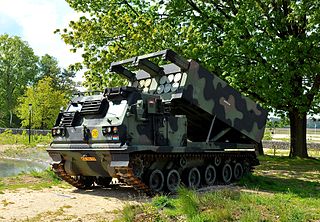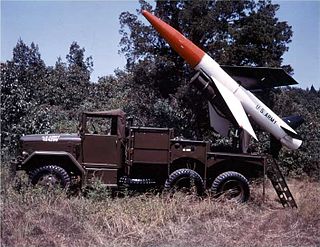The MGM-31A Pershing was the missile used in the Pershing 1 and Pershing 1a field artillery missile systems. It was a solid-fueled two-stage ballistic missile designed and built by Martin Marietta to replace the PGM-11 Redstone missile as the primary nuclear-capable theater-level weapon of the United States Army and replaced the MGM-1 Matador cruise missiles operated by the German Air Force. Pershing later replaced the European-based MGM-13 Mace cruise missiles deployed by the United States Air Force and the German Air Force. Development began in 1958, with the first test missile fired in 1960, the Pershing 1 system deployed in 1963 and the improved Pershing 1a deployed in 1969. The U.S. Army replaced the Pershing 1a with the Pershing II Weapon System in 1983 while the German Air Force retained Pershing 1a until all Pershings were eliminated in 1991. The U.S. Army Missile Command (MICOM) managed the development and improvements while the Field Artillery Branch deployed the systems and developed tactical doctrine.

Nuclear artillery is a subset of limited-yield tactical nuclear weapons, in particular those weapons that are launched from the ground at battlefield targets. Nuclear artillery is commonly associated with shells delivered by a cannon, but in a technical sense short-range artillery rockets or tactical ballistic missiles are also included.

A proximity fuze is a fuze that detonates an explosive device automatically when the distance to the target becomes smaller than a predetermined value. Proximity fuzes are designed for targets such as planes, missiles, ships at sea, and ground forces. They provide a more sophisticated trigger mechanism than the common contact fuze or timed fuze. It is estimated that it increases the lethality by 5 to 10 times, compared to these other fuzes.

Kirtland Air Force Base is a United States Air Force base located in the southeast quadrant of the Albuquerque, New Mexico urban area, adjacent to the Albuquerque International Sunport. The base was named for the early Army aviator Col. Roy C. Kirtland. The military and the international airport share the same runways, making ABQ a joint civil-military airport.

The M270 Multiple Launch Rocket System is an armored, self-propelled, multiple rocket launcher.

The MGM-5 Corporal missile was a nuclear-armed tactical surface-to-surface missile. It was the first guided weapon authorized by the United States to carry a nuclear warhead. A guided tactical ballistic missile, the Corporal could deliver either a nuclear fission, high-explosive, fragmentation or chemical warhead up to a range of 75 nautical miles (139 km).

The Johns Hopkins University Applied Physics Laboratory, commonly known as simply the Applied Physics Laboratory, or APL, located in Howard County, Maryland, near Laurel and Columbia, is a not-for-profit, university-affiliated research center employing 7200 people (2020). The Lab serves as a technical resource for the Department of Defense, NASA, and other government agencies. APL has developed numerous systems and technologies in the areas of air and missile defense, surface and undersea naval warfare, computer security, and space science and spacecraft construction. While APL provides research and engineering services to the government, it is not a traditional defense contractor, as it is a UARC and a division of Johns Hopkins University. APL is a scientific and engineering research and development division, rather than an academic division, of Johns Hopkins.

Located at Kirtland Air Force Base, New Mexico, the Air Force Operational Test and Evaluation Center is a direct reporting unit of Headquarters, United States Air Force. It is the Air Force independent test agency responsible for testing, under operationally realistic conditions, new systems being developed for Air Force and multi-service use.

The MGM-18 Lacrosse was a short-ranged tactical weapon intended for close support of ground troops. Its first flight test was in 1954 and was deployed by the United States Army beginning in 1959, despite being still in the development stage. The program's many technical hurdles proved too difficult to overcome and the missile was withdrawn from field service by 1964.
This Pershing missile bibliography is a list of works related to the Pershing 1 and Pershing 1a Field Artillery Missile Systems and the Pershing II Weapon System.

The 56th Field Artillery Command was a brigade size element of the United States Army. The unit was formed in 1942 with the last period of active service being 1963 through 1991 with the nuclear Pershing missile system.

The Operational Test and Evaluation Force (OPTEVFOR) serves as an independent and objective agency within the United States Navy for the operational testing and evaluation (OT&E) of naval aviation, surface warfare, submarine warfare, C4I, cryptologic, and space systems in support Navy and U.S. Department of Defense acquisition programs.

The 53d Weapons Evaluation Group is a United States Air Force unit that reports to the 53d Wing. It is stationed at Tyndall Air Force Base, Florida. The unit is part of Air Combat Command.

The 32nd AAMDC or 32nd Army Air and Missile Defense Command is a theater level Army air and missile defense multi-component organization with a worldwide, 72-hour deployment mission. The 32nd AAMDC commands echelon above corps (EAC) ADA brigades and other assigned forces. Four such brigades, 11th Air Defense Artillery Brigade, 31st Air Defense Artillery Brigade, 69th Air Defense Artillery Brigade, and 108th Air Defense Artillery Brigade; by training, all stand ready to accomplish their mission of air defense against missile attack – 'anywhere, anytime' in support of the war-fighting combatant commander (CCDR).
A missile combat crew (MCC), is a team of highly trained specialists, often called missileers, manning Intermediate Range and Intercontinental ballistic missile systems. In the United States, men and women, officially coded as Nuclear and Missile Operations Officers, of the United States Air Force, operate underground missile systems at launch control centers located throughout the country. There are also a select few missileers that have the chance to become part of a Missile Combat Crew-Airborne (MCC-A) operating the Airborne Launch Control System which provides a survivable launch capability for the Minuteman ICBM force. Crew size varied among the different missile systems, but the number was always greater than one, to abide by USSTRATCOM's Two-man rule for positive control of nuclear weapons.

From 1960 to 1988 there were Pershing missile launches for testing from various sites in the US. The systems included the Pershing 1 Field Artillery Missile System, the Pershing 1a Field Artillery Missile System and the Pershing II Weapon System. Initial launches were from what is now the Eastern Range at Cape Canaveral, Florida using Launch Complex 30A using the dismounted erector launcher. Later launches were from the full transporter erector launcher (TEL). Further launches were conducted at White Sands Missile Range (WSMR) using tactical equipment. The Pershing 1 and 1a had a range of 740 kilometres (460 mi), thus launches were from various subinstallations into WSMR. The two-stage Pershing II had a range of 1,770 kilometres (1,100 mi), thus launches at WSMR used a single-stage missile with two-stage launches at Cape Canaveral.

Missile Wing 1 was a unit of the German Air Force.

Missile Wing 2 was a unit of the German Air Force. It was activated on 1 January 1965 in Lechfeld with two subordinate units: Missile Group 21 and Missile Group 22.

The Pershing II Weapon System was a solid-fueled two-stage medium-range ballistic missile designed and built by Martin Marietta to replace the Pershing 1a Field Artillery Missile System as the United States Army's primary nuclear-capable theater-level weapon. The U.S. Army replaced the Pershing 1a with the Pershing II Weapon System in 1983, while the German Air Force retained Pershing 1a until all Pershings were eliminated in 1991. The U.S. Army Missile Command (MICOM) managed the development and improvements, while the Field Artillery Branch deployed the systems and developed tactical doctrine.
VX-1, Air Test and Evaluation Squadron One, is a United States Navy air test and evaluation squadron based at Naval Air Station Patuxent River, Maryland.
















